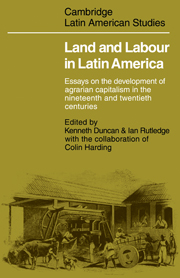 Land and Labour in Latin America
Land and Labour in Latin America Published online by Cambridge University Press: 07 May 2010
During the 1930s, the hostility between the central mill-owners of Pernambuco and their independent cane suppliers, which had been growing since the late nineteenth century, finally reached an acute stage. An outgrowth of this was a body of literature produced by a vigorous school of local writers, who sought to assess the impact on their society of the sugar economy's development over previous decades. Their main argument concerned the excessively high social cost of modernization and the urgent need to halt the destruction of the traditional fabric of the community which it was bringing about.
According to these defenders of the old order, a serious loss was entailed by the growth of the central mills, or usinas, because in the process they were swallowing up the smaller, old-fashioned plantations, known as banguês. This had the result of gradually uprooting the centuries-old class of planters who had presided from the beginning over the nation's destiny and who embodied all that was best in its character. Of no less importance, the usinas were accused of producing a deterioration both in labour relations and in the standard of living of the rural population. The rural labourer, it was claimed, had become a pariah of the usina. Finally, the critique that attempted to vindicate the old engenhos found itself obliged in turn to defend the slave labour system with which they had been identified from the earliest times. Here it was the familiar argument that plantation slaves were often materially better off than their free counterparts locally, or than the proletariat of contemporary industrialized societies.
To save this book to your Kindle, first ensure [email protected] is added to your Approved Personal Document E-mail List under your Personal Document Settings on the Manage Your Content and Devices page of your Amazon account. Then enter the ‘name’ part of your Kindle email address below. Find out more about saving to your Kindle.
Note you can select to save to either the @free.kindle.com or @kindle.com variations. ‘@free.kindle.com’ emails are free but can only be saved to your device when it is connected to wi-fi. ‘@kindle.com’ emails can be delivered even when you are not connected to wi-fi, but note that service fees apply.
Find out more about the Kindle Personal Document Service.
To save content items to your account, please confirm that you agree to abide by our usage policies. If this is the first time you use this feature, you will be asked to authorise Cambridge Core to connect with your account. Find out more about saving content to Dropbox.
To save content items to your account, please confirm that you agree to abide by our usage policies. If this is the first time you use this feature, you will be asked to authorise Cambridge Core to connect with your account. Find out more about saving content to Google Drive.